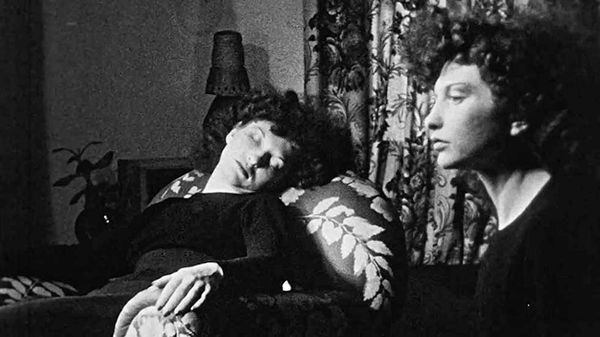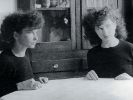Eye For Film >> Movies >> Meshes Of The Afternoon (1943) Film Review
Meshes Of The Afternoon
Reviewed by: Chris

Have you ever stopped to wonder, when you see and touch a flower, what happens inside? Unless you are in purely botanical mode, it may very likely spark off something in your subconscious. The breath of spring. The beauty and harmony of nature. Perhaps something given with affection and gentleness. Maybe even a token of romance?
Maya Deren's wildly seminal work, Meshes Of The Afternoon, begins when a rather artificial looking hand places a flower on a pathway. The hand (and attached arm) pop out of existence, immediately alerting us to the fact that this is not a work of literal storytelling. The symbols of the next 14 minutes drill holes into our subconscious, where images speak louder than words, creating one of the most famous short films of all time.

A woman picks up the flower on her way home. At her doorstep, she drops her key. Once inside, she falls asleep in an armchair. Her dream-self sees her former self approaching the house. But the flower is being carried by a hooded figure whose only face is a mirror. Giving chase brings her no closer to the hooded figure – it just brings her to her doorstep. This time, when she ascends the stairs, we see her expression. No longer carefree, she is watchful, slightly suspicious.
A breadknife, previously cutting bread, lies on the steps. A phone off the hook, and the knife hidden in the bed. She sees her sleeping form and a gramophone playing endlessly with no sound. Through the cracked window she sees herself giving chase to the hooded figure and takes the key from her mouth. We look again. It become a knife with which she confronts two other images of herself. Eventually a man enters the picture.
The sight or touch of a flower reminds us that the subconscious mind works in symbols. Like images from a dream, the flower can bring certain feelings to the surface. Similarly a knife may be just an implement, or an implement with which we can feed ourselves, or hurt ourselves. As with many symbolist/surrealist works, Meshes Of The Afternoon soon evokes Freudian implications. Is the man coming home from work the fulfillment of her romantic dreams or their frustration? As an outside force, he can be a blessing or a threat, just as a mirror can show oneself or a reveal a hidden person.
The music (by Deren's third husband, and added 16 years later) adds to the sense of rising paranoia and dread. Its ritualistic feel has persuaded some commentators to suggest that the double characters and constantly changing identities stem from Deren's interest in Voodoo (her writings on the subject are still a leading authority - she was later initiated as a Voodoo priestess). Yet it wasn't until 1947, four years later, that Deren received a Guggenheim Foundation Fellowship that enabled her to begin visiting Haiti to study Voodoo. More likely they are indicative of an early grasp of psychology, a deep interest of hers and one which she shared with her father.
To signify the hooded figure as the Grim Reaper is also to trivialise and pigeon hole a symbol capable of many equally valid interpretations. Some feminist readings centre on the frustration of a woman left at home all day. Yet we can also look at it in the sense of someone coming to know themselves and risking their sanity in the process.
On a technical level, Meshes Of The Afternoon, shot on a miniscule budget, has almost non-existent production values and may fail easily to engage modern audiences. It has total disregard for Hollywood convention (the word "Hollywood" in the opening titles could even be read as frustration with the barrenness of the industry there). There is some similarity with works by Shirley Clarke or the early surrealism of Bunuel. Structurally, we can see its influence in Lynch´s Lost Highway, where no explanation is given or needed for one thing (or person) turning into another (though some of the explicit symbols are explored more thoroughly in Lynch´s later works, Mulholland Drive and Inland Empire). By understanding Meshes Of The Afternoon, such ´populist´ surrealism becomes child´s play. As a journey of self-discovery with Freudian overtones, it follows a similar (though less tragic) theme to Nina Menkes' Phantom Love.
Some commentators have cast doubt over whether Deren was the primary artistic force in the film, saying it is largely the work of her husband Alexander Hammid. Deren's biographers disagree. Certainly it is her most famous, complex and mature piece of cinema, although her next film, At Land, maintained some of the enigmatic structure of Meshes Of The Afternoon. Later, her works would tail off into dance-focused film (except for her documentary on Voodoo, Divine Horsemen: The Living Gods of Haiti). But whoever was behind Meshes, there are few segments of 14 minutes that remain so disturbing, so infinitely re-watchable, and so influential to this day.
Reviewed on: 23 Mar 2009















